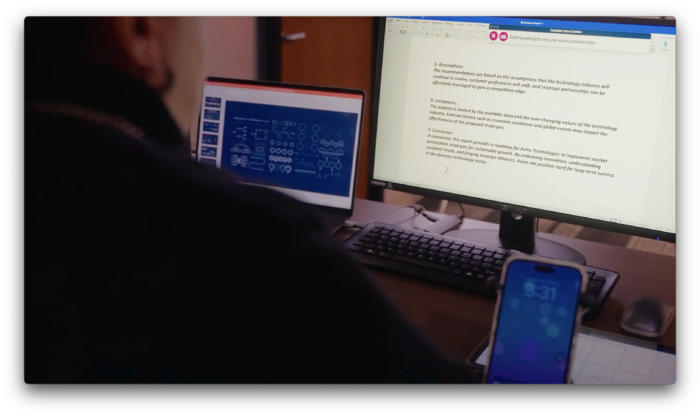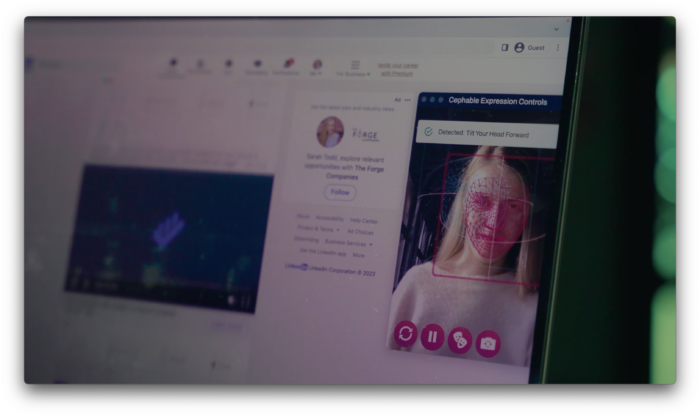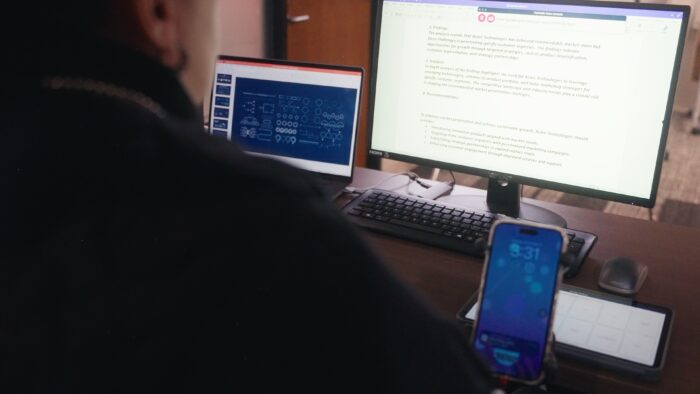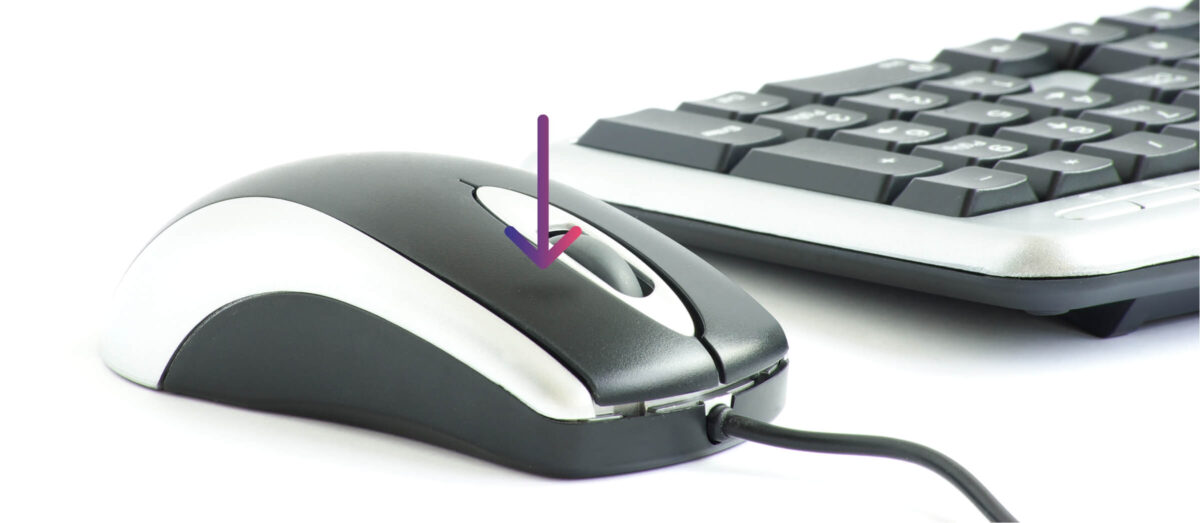The Effect of Alternative Digital Inputs in the Workplace
An Intel RISE Technology Initiative (IRTI) in collaboration with Intel & Accenture

Executive Summary
The Cephable project explores the transformative power of accessible technology in reshaping the modern workplace. As significant global shifts like the pandemic and the rise of hybrid work create new challenges and opportunities, companies have a unique chance to reimagine their work environments and tools. The Intel RISE Technology Initiative (IRTI), in collaboration with Accenture and Cephable, highlights the critical role of accessible technology in enhancing workplace inclusivity and productivity, for the entire workforce, and most specifically for employees with disabilities. Innovations such as voice-controlled interfaces, head movement tracking, and facial expression recognition are revolutionizing how individuals with disabilities interact with digital workspaces, while also benefiting their non-disabled peers.
By addressing the gap between knowing what to do and effectively implementing it, organizations can harness the full potential of their workforce. This paper emphasizes companies that view employees as revenue assets rather than operating costs, are building higher standards of culture with work outputs that are gleaning stronger results. It calls for an examination, and in some cases, a redesign of work processes to support evolving methods, fostering a more inclusive, innovative, and productive work environment.
Introduction
This white paper is part of a project funded by the Intel RISE Technology Initiative to further explore that belief in the pivotal role accessible technology can play in shaping and reimagining how work is accomplished.
The IRTI program is a comprehensive platform designed to leverage Intel’s technology, expertise, and partnerships to address global challenges across six key areas: accessibility, economic recovery, education, health and life sciences, social equity and human rights, and sustainability and climate. For Accenture, it is further evidence of their growing accessibility commitment from the company, including their accessibility centers and best-in-class accommodations search tool. In 2024, the IRTI funded a project in collaboration with Accenture and Cephable, an assistive technology company, to collaborate with employees with disabilities to highlight the benefits of face, voice, and head controls in accomplishing common work tasks.
Accessibility is an overlooked workplace imperative that guarantees technology will perform better for employees with disabilities and improve functionality and usability in yet-to-be-imagined ways. By highlighting project outcomes, user experiences, and global trends, we aim to demonstrate the tangible benefits of accessibility investments.
The ROI of Human Potential
The battle for extraordinary talent is never-ending and successful companies are prioritizing workplace satisfaction and human potential to meet and exceed business objectives. Accenture’s 2022 Future of Work research found that only 26% of CEOs have “future workforce strategies” in place. Successful companies understand that focusing on the well-being of their employees is a strategic advantage that will drive business goals, and well-being cannot fully be realized without supplying the tools needed to be successful on the job.
Employees who feel they cannot be productive, healthy, or happy in any work location are eight times more likely to want to leave their organization. Specifically, 75% of employees with disabilities do not disclose their disabilities at work, indicating a need to reimagine the entire framework, from training to accommodations.
Research consistently shows that businesses investing in accessible technology and future workforce strategies outperform their peers. Viewing accessible technology as the necessary tools employees need to unleash productivity and address an innovation lag is crucial and should be as standard as being handed an ID badge to get into the building. How people work has outpaced the systems designed to support us, highlighting that the time is here to redesign how we work. As the workplace continues to evolve with trends like hybrid work and digital transformation, the need to reimagine work environments and tools has never been more critical.
We are at the start of a new era, and companies are at a crossroads with the ability to reimagine the workplace, both physically and virtually, and the tools needed to be productive. A paradox is also at play for enterprises claiming to be innovative while trying to force their employees to fit into stagnant strategies. By re-examining the everyday technology of business, leaders can capitalize on this moment and discover how to release greater potential within their workforce.
Next Generation Productivity
In 2023, less than two months after the initial launch of ChatGPT, more than 100 million individual users visited the platform to try the technology, and the platform currently receives more than 10 million queries on any given day. This giant swell of curiosity into AI (Artificial Intelligence), its functionality, and its usefulness is a sea-change moment for new and innovative ways to accomplish work. Employees are actively seeking tools to bring new productivity levels into their jobs.
While ChatGPT is a prime example of an outlet for finding and processing information more quickly, the modalities we use to get to that information have mainly remained untouched (e.g., think in terms of the standard keyboard and mouse functions).
A recent Gallup poll (May 2024) asked its global CHRO roundtable members, whose department supports most culture transformations, how often their company’s employees were using AI to do their jobs and 44% had no level of understanding about how their employees were using AI, while 43% of employees are reporting that they use AI to help complete everyday tasks.
The AI shift is happening quickly, and companies need to be more in tune with not only how their employees are using technology, but also how technology can improve everything from productivity, efficiency, and communication and connection. This can be a moment where companies reshape and rethink the tools needed to process the information in new and efficient ways. How technology is and will be incorporated into the structure of the workday is essential to a company’s productivity, agility, and the ability to remain competitive.
Accessible technology and the belief that companies should invest in inclusive digital systems are strategic choices. These investments have positive ramifications for all employees, including those with disabilities.
Accessibility is an overlooked, underutilized, and under-resourced imperative that guarantees technology will perform better for employees with disabilities and improve functionality and usability in yet-to-be-imagined ways. Accessible technology and the belief that companies investing in digital systems that are inclusive and usable for people with disabilities is a strategic choice that has positive ramifications for all employees. By highlighting project outcomes, user experiences, and global trends, we aim to demonstrate the tangible benefits of accessibility investments.
Fast Facts on Disability
• Roughly 1 in 4 people identify as having at least one disability in the US, and 16% of the global population are disabled.
• Disability is the largest and fastest-growing minority population in the world.
• By 2025, 50% of IT organizations will have established a digital employee experience strategy, team, and management tool, up from less than 20% in 2023.
• Over 90% of company websites are inaccessible to people with disabilities
• Almost 74% of workplace software is difficult to navigate even with assistive technology
• Modern definitions of disability include permanent (e.g., cerebral palsy), temporary (e.g., broken arm), and situational (e.g., environment-based), and include everything from physical disabilities to learning differences and mental health.
Five Stats on the Future of Accessible Tech
- Growth in Assistive Technology Market: The global assistive technology market is projected to reach $26.8 billion (about $82 per person in the US) by 2024, with a compound annual growth rate (CAGR) of 7.9% from 2019 to 2024. This growth reflects increasing demand for innovative solutions to address the diverse needs of individuals with disabilities in various aspects of life, including education, employment, and daily living.
- Rising Adoption of Voice Assistants: Voice assistants, such as Amazon’s Alexa and Apple’s Siri, are becoming increasingly popular among individuals with disabilities. According to a report by Voicebot.ai, approximately 32% of Americans with disabilities use voice-assisted devices or software, highlighting the role of voice technology in enhancing accessibility and independence for users with diverse abilities.
- Digital Accessibility Legislation: Governments around the world are implementing regulations and standards to promote digital accessibility. For example, the European Union’s Web Accessibility Directive requires public sector websites and mobile applications to be accessible to people with disabilities, driving organizations to prioritize accessibility in their digital initiatives. Similar legislation exists in countries like the United States, Canada, and Australia, signaling a growing emphasis on digital inclusivity.
- Increasing Emphasis on Inclusive Design: Inclusive design, which involves designing products, services, and environments to be usable by people of all abilities, is gaining traction among businesses and organizations. Research by the Center for Inclusive Design and Environmental Access (IDeA Center) indicates that every dollar invested in accessibility results in a $4 return, highlighting the economic benefits of inclusive design practices.
- Emerging Technologies for Accessibility: Emerging technologies such as artificial intelligence (AI), augmented reality (AR), and wearable devices hold promise for improving accessibility. For example, AI-powered image recognition systems can assist individuals with visual impairments in accessing visual information, while AR applications can provide real-time navigation assistance for people with mobility limitations. As these technologies continue to evolve, they have the potential to further enhance accessibility and foster greater independence for individuals with disabilities.’
The Business Case for Accessible Technology in the Workplace
Reframing Disability as a Market, Workforce, and Innovation Hub
Business is undergoing a transformative shift as more companies recognize the value of disability inclusion. Forward-thinking organizations are increasingly harnessing the power of disability inclusion, with an understanding that it drives innovation, enhances employee engagement, and opens new market opportunities.
It is the businesses embracing aligning inclusion strategies and culture activities that stand to gain significantly as statistics reveal the increasing prevalence of disabilities globally, underscoring the urgency of prioritizing accessibility. According to the World Health Organization, over one billion people, or approximately 16% of the world’s population, live with some form of disability. This number is expected to rise due to aging populations and the increase in chronic health conditions. In the United States alone, people with disabilities control over $695 billion (about $2,100 per person in the US) in disposable income. These figures highlight the critical importance of making workplaces and products accessible as a strategic business decision.
Disabled consumers and employees are the extreme users of any product or service, pushing capabilities beyond initial envisioned limits, to understand what is possible. Some of the world’s most common access solutions were first created as accessible additions to meet the needs of disabled users, including texting, voice enabled assistants, and automatic doors. A legitimate argument, with backing data, is that when companies design for disabled users, they build stronger products that lean further into innovation, requiring less refurbishments, and offering a greater competitive advantage.
This shift is driven by a growing awareness that disability inclusion is not merely a matter of compliance or social responsibility, but a strategic advantage that can lead to improved performance, increased customer loyalty, and a stronger brand reputation. As a result, businesses that prioritize disability inclusion are positioning themselves as leaders in a rapidly evolving marketplace, demonstrating that inclusivity and profitability can go hand in hand.
Market Drivers for Accessibility:
- Thriving Employees and a Sustainable, Productive Workforce: Inclusive workplaces foster employee engagement, satisfaction, and retention, driving productivity and innovation.
- Competitive Advantage: Organizations that prioritize accessibility gain a competitive edge by tapping into new markets, attracting top talent, and enhancing brand reputation.
- Compliance and Risk Management: Legal and regulatory requirements necessitate accessibility compliance, mitigating legal risks and safeguarding against reputational harm.
- Digital Trust: Building trust with customers and stakeholders requires demonstrating a commitment to accessibility and inclusivity in all facets of business operations.
The Cephable IRTI Project
Overview of the Project
In an insights-driven initiative, Intel and Accenture have collaborated with Cephable, a technology firm specializing in accessibility solutions, to launch a project focused on how head, voice, and face movements can improve digital workplace experiences for people with disabilities. This project aimed to explore and highlight innovative technologies that enable individuals with disabilities to navigate their work environments and interact with their colleagues more effectively. Cephable’s software was used in a wide array of situations and paired with an equally wide variety of applications. Everything from Microsoft Mesh’s immersive tech (that is part of the next wave of virtual meeting places) and avatars to everyday tasks like developing and presenting PowerPoint decks. By focusing on these specific types of activities, the project seeks to create tailored solutions that enhance accessibility and inclusivity in the workplace.
Both Intel and Accenture have thousands of employees with disabilities, who on any given day are utilizing dozens of software applications and supporting tools while incorporating accommodations across those activities. Additionally, Cephable has a user base of thousands of people with disabilities, and a curated focus group of disabled users called the “consortium” who incorporate the software at work and home to provide feedback on the product. The IRTI project used a representative sample of Intel and Accenture employees, as well as members of the consortium to test Cephable in workplace settings and provide insights on its ability to improve digital experiences.
Why Does This Matter?
In 2020, Accenture produced new research entitled “Enabling Change” which surveyed people from over 100 companies and across 28 countries. Survey respondents comprised over 6,000 employees with disabilities and 2,000 C-Suite executives. An alarming finding was that 76% of employees with disabilities and 80% of leaders with disabilities face fears about their disability and their needs in the workplace. This statistic is further compounded by the drastic rise in external corporate commitments advancing disability inclusion and hiring initiatives. This worrisome contradiction will likely bear out in the data over the next few years, as while companies are doing more to hire and count disabled employees, the culture and support systems are not aligning to ensure employees are productive and thriving. This tremendously impacts a company’s ability to achieve objectives, reduce turnover, and capitalize on talent. In other words, it is like building a house and only giving every fourth worker a box of nails – how quickly will they finish, and how sturdy will the final product be?
Overview of Cephable
Cephable is an assistive technology company with cutting-edge software that leverages AI, automation, and accessible UX design to redefine digital experiences. The company’s patent-approved features optimize user interfaces through facial expressions, body gestures, virtual buttons, voice commands, and tilt controls, engineered to adapt to every ability. To see a demonstration of the software and to frame the use case, watch this video: insert link
Objectives and Goals
The project’s primary objective was to understand how head, voice, and face movements can be leveraged to improve accessibility for individuals with disabilities in both traditional work activities and in newer immersed virtual workplaces. The project aimed to identify where Cephable’s technology could improve those digital interactions, create wins for users as they navigated tasks, and unearth gaps in existing solutions that can be mitigated by a more customizable offering.
Specific goals include:
- Mapping the Movement Patterns: Analyzing which features for head, voice, and facial movements have the strongest results with various disabilities to identify commonalities and differences.
- Examining the Benefits of Updated Technology: Understanding how adaptive technologies are facilitating more accessible interactions with workplace tools and how outdated tech, currently being offered to employees, is causing needless frustration, friction, and an outsized business expense.
- Identifying Implementation Strategies: Developing strategies for integrating these technologies into existing workplace infrastructures, ensuring seamless and effective adoption.
- Addressing Impact Assessments: Measuring the impact of these technologies on workplace productivity, employee satisfaction, and overall accessibility.
- Emphasize Importance of Executive Buy-in: Involve key leaders in the project to gain insights on opportunities and challenges.
Research Methodology
The project employs a multi-faceted feedback approach, combining qualitative and quantitative methods. Key components of the feedback methodology include:
- • Surveys and Interviews: Conducting detailed surveys and interviews with individuals with disabilities to gather insights into their experiences and specific results from using Cephable with existing software systems.
• User Testing: Providing Cephable to participants in various workplace settings to understand how they adapted to integrating these movements into their workday and identify areas for improvement.
• Data Collection and Analysis: Collecting and analyzing data on the effectiveness of these technologies, focusing on metrics such as ease of use, efficiency, and user satisfaction.
Participant Demographics
Testers Demographic Information
- Disability representation Over 88% of testers have a stated disability that represents a wide variety of conditions. 12% of testers do not have a stated disability.
- Identity representation Testers represented a variety of geographies, identities, races, and genders
Role within organization Testers represented over 20 unique functions across various business units presenting a wide variety of use cases for the technology
Technical proficiency, self-assessment:
- 62% felt they are tech savvy but not experts
- 18% felt they are novices at integrating assistive tech
- 19% felt they are tech experts or have a professional focus on technology
Insights and Innovations
Employees at Accenture, Intel, and other disabled users agreed to blend Cephable into their work activities for a defined two-week period to examine the impact of face, voice, and head controls in completing daily tasks. The testing period was followed with interviews and surveys to collect and aggregate the impact results.
Key findings from the project highlight the development of advanced voice-controlled interfaces, head movement tracking, and facial expression recognition technologies do bring ease to most users and reduce everyday frustrations. These innovations enable individuals with disabilities to interact with digital work environments more effectively, reducing reliance on manual input and enhancing overall user experience. By integrating these technologies, businesses can unlock greater potential within their workforce, fostering a more inclusive and productive workplace.
Accessibility Findings
Finding Statement
- Finding One: Assistive technology has a profound impact on users’ lives, significantly aiding those with temporary injuries and demonstrating the potential for broader societal impact.
- Finding Two: Assistive technology eases both physical and mental stress, enhancing users’ capabilities in their job and personal life.
Finding Three Assistive technology is particularly valuable to people with disabilities from the start, though its benefits can extend to all users over time. - Finding Four: Assistive technology offers a superior user experience compared to other tools, reducing frustration, and improving usability for individuals with disabilities, particularly those with traumatic brain injuries (TBI).
- Finding Five: Assistive technology provides a valuable alternative for users – with or without disabilities – who need breaks from traditional input methods like mousing and keyboarding, promoting varied interaction methods. This finding is based on non-disabled users finding ergonomic benefit and a solution to avoid repetitive injuries.
- Finding Six: The simplicity and life-improving capabilities of assistive technology are highly appreciated by users, contributing to overall satisfaction.
Findings for the Specific Use of Cephable
Category Statistic/Rating
- Cephable Ease of Use – 74%
- Cephable Likely to Use in Everyday Work Settings – 73%
- Cephable Reducing Fatigue – 83%
- Likelihood to Use Cephable if Provided by Employer – 81%
Additional Impact Insights:
- Just over 20% of respondents deleted current technology and replaced it with Cephable, even without a full Cephable integration because of the advantage of updated technology that included large language models.
- The convergence of significant global shifts, such as the pandemic, the great resignation, and hybrid work, has transformed the workplace, providing an opportunity to reimagine work environments and tools.
- Innovations in assistive technology, such as voice-controlled interfaces, head movement tracking, and facial expression recognition, are beneficial in enhancing workplace inclusivity and productivity.
- Developing a roadmap for a centralized and well-communicated accommodation process is vital. By modeling Accenture’s structure, which includes a central Accessibility Center of Excellence and regional Accessibility Centers, companies can streamline accommodation requests, enhance support for employees with disabilities, and foster a more inclusive work environment.
- Executive buy-in is critical for driving innovation and the adoption of accessible technology, as highlighted by Josh Newman’s insights on the collaborative efforts and the necessity of assistive tech for all.
Unexpected Insight:
An unexpected insight of the project revealed that attention to ergonomics expanded the usefulness of alternative inputs to the entire workforce, not just people with disabilities. Cephable proved instrumental in stopping warning indicators of excessive keyboard and mouse usage, demonstrating that the product is beneficial for both people with and without disabilities. This underscores the universal applicability and value of Cephable in promoting workplace health and efficiency.
The Importance of Executive Buy-In: Insights from Josh Newman:
In an interview with Josh Newman, Vice President and General Manager of Product Marketing and Management in the Client Computing Group at Intel, the critical role of executive buy-in for the success of accessible technology initiatives was underscored. Newman highlighted the collaborative efforts of various partners, software vendors, and technology companies working together to solve specific problems, leveraging the open platform of the PC. He emphasized that assistive technology is not a distant future necessity but a current imperative that will eventually benefit everyone, whether permanently or temporarily. Newman’s insights reinforce the importance of executive leadership in driving innovation and adoption of accessible technology, ensuring that organizations are well-equipped to support a diverse and inclusive workforce.
Josh Newman Statements:
“And it is because of all of the innovation happening and then all the different partners, all the different software vendors, all the different technology companies that are trying to solve specific problems that will then only work on the PC because the PC is such an open platform to do it on.”
“It is that idea that assistive technology is not just for someday, it is for now. We are all going to need assistive technology of some sort, maybe permanently, maybe temporarily – but the baseline truth is that it is a universal need.”
User Statements
The impact of assistive technology in the workplace is best understood through the voices of those who benefit from it. The following quotes are a part of the outcomes from the experience of user testing illustrating the profound difference that advanced accessibility tools can make in the daily lives of employees with disabilities. These testimonials highlight not only the enhanced functionality and ease of use but also the significant improvements in overall job satisfaction and personal well-being. By sharing their experiences, these users underscore the transformative power of inclusive technology in creating a more equitable and efficient work environment for all.
Next Steps & Levers for Change
If we focus on the human factor—if we prioritize humans—the shifts in the workplace become much less daunting. The definition of human performance extends beyond mere productivity to encompass potential, well-being, and engagement. However, there remains a significant gap between knowing what to do and being able to act. Leaders often experience “productivity paranoia,” fearing that employees are not working efficiently, while 48% of workers and 53% of managers report feeling burned out. This burnout is a symptom of a system that fails to measure true potential and provide the needed tools to succeed on the job, focusing instead on outdated metrics of productivity. Research consistently shows that while leaders know what needs to be done to support their teams, they struggle to operationalize these insights effectively. Simultaneously, workers are acutely aware of their needs but lack confidence that these needs will be met. By seeing employees as assets rather than costs, we can bridge this gap, ensuring that both leaders and workers can thrive in an evolving work environment.
The time to act is now.
About Us:
About Accessibility at Cephable
Cephable is committed to driving accessibility innovation through collaboration, research, and advocacy. Partnering with industry leaders such as Accenture and Intel, we are dedicated to creating a more inclusive future for all.
The productivity paradox can be overcome through pioneering workplace innovation fueled by accessibility. By ensuring that technology is something people with disabilities love to use, deserve to have, and can easily integrate into their lives, we can create a more equitable and prosperous future for all. For too long, people with disabilities have been paying for their own accessibility needs to fully use products and services. It is time to change that narrative and ensure the companies understand the power of the disability market.
To learn more: Accessibility at Cephable
About Accessibility at Intel
Technology is an integral tool to help people with disabilities live independently and participate fully in all aspects of life. It is so critical it is considered a fundamental human right, according to the United Nations Convention on the Rights of Persons with Disabilities. At Intel, we embrace accessibility across our business. We strive for an inclusive and accessible workplace; we practice inclusive design in product development, and we engage with industry to advance accessibility across the tech ecosystem.
Intel’s accessibility operating model is comprised of a cross-organizational team that touches almost every part of the company. The group focuses on maturing accessibility across our operations – from making all campuses accessible, to working with suppliers to meet our accessibility standards, and ensuring our products comply with global accessibility requirements.
To learn more: Intel’s Accessibility Overview.
About Accessibility at Accenture
At Accenture, we are enabling change with a central Accessibility Center of Excellence to proactively meet the needs of our people with disabilities, along with Accessibility Centers in seven separate locations around the world. The goal of the centers is to provide a space where persons with disabilities can interact with accessible technology, demonstrating our accessible design leadership and best practices. We invested in our applications to ensure that the vast majority are accessible, and we have supplemental resources to navigate additional accessibility requirements. For example, through our Adjustment Request Tool, any employee with disabilities can easily ask for an accommodation such as assistive technology, flex work arrangements, sign language interpreters, screen readers and more. And, to inspire growth, we launched Abilities Unleashed, a unique internal development program for persons with disabilities to become authentic leaders and effective role models and to explore career paths and development opportunities.
To learn more: Accenture’s Accessibility Overview
Resources
- https://www.afb.org/aw/summer2023/challenges-with-AT-in-workplace
- https://www.intel.com/content/www/us/en/newsroom/opinion/leveraging-intel-technology-force-for-good.html#gs.93o8vl
- https://www.accenture.com/us-en/case-studies/about/accessibility-every-moment
- https://www.accenture.com/content/dam/accenture/final/a-com-migration/pdf/pdf-142/accenture-enabling-change-getting-equal-2020-disability-inclusion-report.pdf
- https://www.edelman.com/trust/trust-barometer
- https://www.scanningpens.blog/news/2022/11/10/a-short-history-of-assistive-technology
- https://www.accenture.com/us-en/insights/consulting/future-work
Cephable turns any input into any output.
















